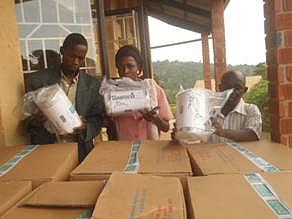Mama Kits: HIV Alliance Donates Mama kits to PHA groups

Receiving mama kits
The International HIV/AIDS Alliance has donated mama kits to Luwero and Nakaseke district groups of persons living with HIV. The mama kits provided for year I and year II are worth 4,500,000 Uganda shillings about US $1662.
Mama Kits’ contain basic materials to facilitate clean and safe delivery and reduce the risk of infection to the mother and her new-born baby. These include two pairs of gloves to prevent infections, two new razor blades to cut the umbilical cord, one bar of soap, two gauze pads for cleaning the eyes of the new-born, eight sanitary towels for the mother, nine oz of cotton wool and one polyethylene sheet on which the mother can give birth.
According to Jeniffer Gaberu, the Alliance team leader for the VIIV funded PMTCT project, “These kits are for year one and two budgets. Each group has a budget of 2,128,000 ($832) each year, meaning that for the 2 years it is 4,256,000 ($1662) for each group. For the 3 networks in Luwero and Nakaseke each, it then becomes 25536000 (US $9975) for the two years”
Management of mama kits
According to Abdallah Zziwa Musisi the in charge of Luwero Forum of Persons living with HIV:
“We agreed as a group in Nyimbwa that we should handle the mama kits with care and they should be for emergency and reserved for pregnant mothers who are diagnosed to be HIV positive. We also agreed that after the distribution, we should follow up to see whether these mama kits have been used for the purpose for which they are supposed to serve.”
In the group’s deliberation meetings on how the mama kits should be distributed, some members suggested that all mama kits should be distributed out to the smaller groups. But it was realised later on that the groups did not have proper storage and safe custody for the supplies. It was therefore agreed that for the smaller groups within Nyimbwa PHA, each be given 5 maama kit packs for distribution. After all the five are distributed more be collected from the main centre.
Expanding and increasing the content of mama kits bag
Namubiru Beatrice a mother of two says that,
“There is a lot of room for improving the maama kit pack. We need resources like emergency lighting and something that can stimulate breast milk for the mothers. This could be something edible. Most of us face a problem of lack of breast milk immediately after delivery”
But Zziwa recommends addition of “Some hygiene and sanitary ware or towels for babies for mothers in the rural communities. These will go a long way in reducing infections among the newly born babies”
There has also been debate that Misoprostol a drug which is administered after delivery to prevent bleeding among women be included in the mama kits. The Uganda maternal mortality ratio stands at 438 women per 100,000 with bleeding accounting for 25% of the deaths. It is presumed that when Misoprostol is included in the pack, deaths form bleeding may be reduced.
But there is also concern that Misoprostol can be used for inducing abortions as an alternative to surgical abortion. Some experts warn that if Misoprostol is let loose in the rural areas, it will be misused for inducing abortion.
Uganda’s Health sector and challenges
According to Dr. Tusingwire Collins, a commissioner at the Uganda Ministry of Health,
“One of the Strategic Interventions for reduction of Maternal and child mortality in Uganda is use of VHTs, to mobilize and register pregnant women, refer for utilization of services (Family Planning, ANC, Maternity and Postnatal), report maternal and perinatal deaths including verbal auto, Increasing access to institutional deliveries and Emergency Obstetric Care, recruitment of critical cadres of Health providers and community distribution of Family Planning commodities”
Dr. Tusingwire says the major challenges to the Uganda health sector are inadequate critical cadre of Health workers to offer Reproductive Health services at all levels; Long procurement processes; Low demand for Reproductive Health services. Lack of vital tools like partographm, MPDR, side effects, management protocols and a very high fertility rate of 6.2 children per woman.
Achievements
At the moment the Health sector has succeeded in the operationalization of regional Blood Banks in Gulu,Mbale, Fortport and Mbarara and at the moment 100% of hospitals and 25% HC IVs offer Comprehensive EmONC.. In addition all HC IIIs offer Basic Emergency obstetric care (BemONC) and approximately 30% of HC IIs offer BemONC while they have also recruited critical cadres to offer RH services with 196 doctors, 1067 midwives and 53 Anesthetic officers.

